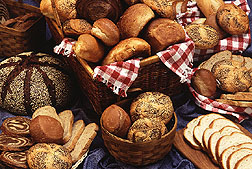FIBRE
Fibre – It’s time to boost your intake!
By Lynn Roblin MSc.RD.

If you’ve been avoiding whole grains, vegetables and fruit, you’re fibre intake is probably at an all time low.
Fibre is important for adults and kids alike. It helps promote regularity and may prevent disorders of the digestive system. When combined with a low-fat diet, fibre helps reduce blood cholesterol levels and the risk of heart disease. Eating a fibre-rich diet may also help prevent some types of cancer and helps people with diabetes control their blood sugar levels. Eating plenty of high-fibre foods can also help with appetite and weight control.
We get fibre from eating all sorts of different plant foods. We don’t get fibre when we eat meat or milk products.
Fibre-rich foods include wheat bran breakfast cereals, bran muffins, oatmeal, whole-grain breads and brown rice. Vegetables and fruit all provide fibre in varying amounts. Eating skins and peels of fruit or vegetables more often than drinking the juice will help you get more fibre. Choosing meat alternatives such as peanut butter, nuts, seeds, dried beans, peas and lentils is another way to get more fibre in your diet.
There are two different types of fibre; both are important in your daily diet to promote health.
Insoluble fibre, found in foods such as wheat bran, whole grain products and some vegetables, helps promote regularity. It also helps prevent and treat diseases of the colon.
Soluble fibre is found in grains such as oats, barley and psyllium; dried beans, peas and lentils; some vegetables and fruit. Soluble fibre plays a role in lowering blood cholesterol levels and controlling blood sugar levels.
How much fibre should you eat?
Most Canadian adults consume less than 15 grams of fibre per day. According to the National Academy of Sciences women should aim for 25 grams and men 38 grams of fibre per day.
Children also require fibre, but most kids just don’t get enough. Children ages 4 to 8 years of age should aim for 25 grams of fibre per day. Girls 9 to 18 years old should get 26 grams per day, while boys 9 to 18 years old should aim for 31 – 38 grams of fibre per day.
The reason most of us don’t get enough fibre is simple – we don’t consume enough vegetables and fruit or whole-grain breads and cereals. Follow Canada’s Food Guide to get the number of servings you need from each of these food groups each day. Have vegetables and fruit more often than juice and make at least half of your grain products whole grain each day..
To be called high-fibre, a food must contain at least 4 grams of dietary fibre per serving. Here are some high-fibre choices:
- All Bran type cereal (1/2 cup) 11.8 grams
- Oat Bran, hot cereal (1 cup) 11.5 grams
- Whole-grain waffles (2) 6.0 grams
- Bran flakes with raisins (3/4 cup) 4.4 grams
- Whole wheat pita bread (1) 4.4 grams
- Oatmeal, cooked (1 cup) 4 grams
- Peas, green, cooked (1/2 cup) 5.6 grams
- Brussels Sprouts, cooked (1/2 cup) 5.2 grams
- Pear, raw with skin (1) 5.1 grams
- Sweet Potato, cooked (1/2 cup) 4.4 grams
- Kidney beans, canned (1/2 cup) 8.3 grams
- Baked beans in tomato sauce, canned (1/2 cup) 10.4 grams
- Lentils, cooked (1/2 cup) 4.2 grams
